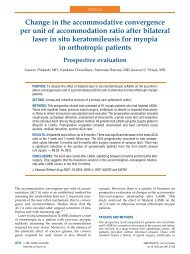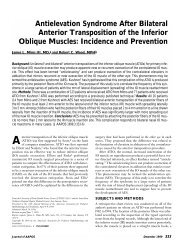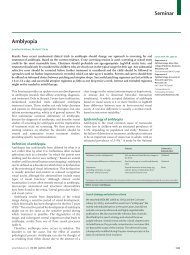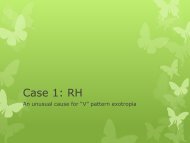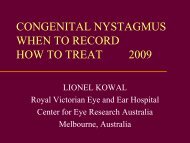What's new AAPOS 2008 - The Private Eye Clinic
What's new AAPOS 2008 - The Private Eye Clinic
What's new AAPOS 2008 - The Private Eye Clinic
You also want an ePaper? Increase the reach of your titles
YUMPU automatically turns print PDFs into web optimized ePapers that Google loves.
NEURO-OPHTHALMOLOGY<br />
Adverse effects of apraclonidine used in the diagnosis of Horner’s syndrome in<br />
infants.<br />
Watts T, Satterfield D, Kim MK.<br />
J <strong>AAPOS</strong> 2007; 11: 282-83.<br />
<strong>The</strong> authors present an index case of a five-month-old infant girl along with four<br />
additional cases provided through the pediatric ophthalmology listserve. Three of these<br />
children had drowsiness and two cases required emergency admission for<br />
unresponsiveness. One case had associated bradycardia, hypertension, and<br />
decreased oxygen saturations. <strong>The</strong> authors recommend that apraclonidine be used<br />
with caution or not at all in infants under six months of age. If used the patient should<br />
be observed for a period of at least two hours after installation of the drops with<br />
admission to the pediatric ward if lethargy, bradycardia or reduced respiratory rate<br />
develop.<br />
Pediatric idiopathic intracranial hypertension<br />
Rangwala LM, Liu GT. Surv Ophthalmol 2007; 52: 597-617.<br />
This review article summarizes currently knowledge regarding pediatric idiopathic<br />
intracranial hypertension. <strong>The</strong> use of rigorous methodologies and standard definitions<br />
in recent studies has demonstrated distinct demographic trends: (1) <strong>The</strong> incidence of<br />
idiopathic intracranial hypertension seems to be increasing among adolescent children,<br />
and among older children its clinical picture is similar to that of adult idiopathic<br />
intracranial hypertension (female and obese). Within younger age groups there are<br />
more boys and nonobese children who may develop idiopathic intracranial<br />
hypertension. (2) <strong>The</strong> pathogenesis of the disease has yet to be elucidated. Idiopathic<br />
intracranial hypertension among young children has been associated with several <strong>new</strong><br />
etiologies, including recombinant growth hormone and all-trans-retinoic acid. (3) More<br />
modern neuroimaging techniques such as MRI and MRI-venograms are being used to<br />
exclude intracranial processes. (4) Although most cases of pediatric idiopathic<br />
intracranial hypertension improve with medical treatment, those who have had visual<br />
progression despite medical treatment have undergone optic nerve sheath fenestration<br />
and lumboperitoneal shunting. (5) Because idiopathic intracranial hypertension in<br />
young children appears to be a different disorder than in adolescents and adults,<br />
separate diagnostic criteria for younger children are warranted. <strong>The</strong> authors propose<br />
<strong>new</strong> criteria for pediatric idiopathic intracranial hypertension in which children should<br />
have signs or symptoms consistent with elevated intracranial pressure, be prepubertal,<br />
have normal sensorium, can have reversible cranial nerve palsies, and have an opening<br />
cerebrospinal fluid pressure greater than 180 mm H 2 O if less than age 8 and<br />
papilledema is present, but greater than 250 mm H 2 0 if age 8 or above or less than 8<br />
without papilledema.<br />
74



